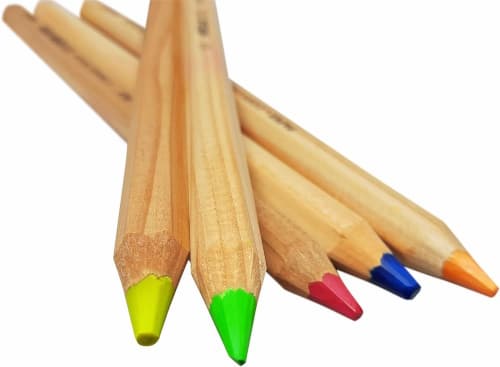
24 November, 2023
The World of Highlighters: Types, Manufacturing, and Pros & Cons
Highlighters are essential tools in the realm of writing instruments, widely used by students, professionals, and readers to emphasise important text. In this blog, we look into the different types of highlighters available in the market, their manufacturing process, and the pros and cons of each type.
Types of Highlighters
1. Liquid Ink Highlighters

The birth of liquid ink highlighters involves a nuanced process centred around the formulation of the ink itself, which is typically a mixture of water or alcohol-based solution and pigments. These vibrant pigments lend the bright hues that highlighters are known for. There are several steps in the manufacturing process
- Pigment Extraction and Mixing: The initial phase involves extracting and mixing pigments from various sources to achieve the desired colour. The pigments are then dissolved in a water or alcohol-based solution to create a liquid ink.
- Tip Formation: The tips of these highlighters are fabricated using porous materials, such as felt or compressed fibres, which can hold and evenly distribute the ink as it flows.
- Assembling the Body: Simultaneously, the plastic body of the highlighter is moulded using resins to house the ink reservoir. This involves the creation of a robust and ergonomic design ensuring a comfortable grip and ease of use.
- Ink Filling: Post the assembly of the body, it is filled with the ink, creating a reservoir that feeds the porous tip, ensuring a steady and consistent flow of ink during usage.
Advantages of Liquid Ink Highlighters
- Vibrant and Bright Colours: The dominant advantage lies in their offering of vibrant and bright colours, enhancing readability and making the highlighted text stand out prominently.
- Variety of Tip Sizes: These highlighters come in an array of tip sizes, from broad tips for highlighting large text areas to fine tips for underlining and detailing, catering to various user needs.
Disadvantages of Liquid Ink Highlighters
- Bleeding Through Pages: The liquid ink has a propensity to seep through paper, especially thin pages, leading to messiness and compromising the neatness of the work.
- Drying Out: If not capped properly post-usage, they can dry out rapidly, reducing their lifespan and resulting in wastage.
Liquid ink highlighters are great for their bright and vivid output. Despite the challenges of potential bleeding and drying out, understanding their manufacturing process and handling them with care can go a long way in leveraging their benefits optimally. Whether you're a student fervently highlighting study materials or a professional marking critical points in a report, liquid ink highlighters can potentially be your go-to tool, promising vibrancy and precision in your endeavours.
2. Solid Gel Highlighters

Solid gel highlighters bring unique properties to the table, including a crayon-like application stemming from a distinct wax-like consistency.
They are created through a distinct manufacturing pathway that differentiates them from their liquid ink counterparts. Here, we break down the journey from production to application:
- Gel Formulation: The heart of these highlighters is the solid gel, which is synthesised using a mixture of wax and gel, combined with pigments to achieve the desired colour spectrum.
- Moulding the Gel: Once the gel is formulated, it is moulded into the appropriate shape, resembling a crayon’s form, facilitating easy application.
- Housing the Gel: The moulded gel is then housed in a retractable casing, often plastic, which protects the gel and allows for convenient usage and storage.
Advantages of Solid Gel Highlighters
- No Bleeding Through Pages: They offer the significant benefit of not bleeding through pages, preserving the integrity of the paper and allowing for clean and neat highlighting on both sides of the paper.
- Long-lasting: Thanks to their solid state, they promise a long lifespan, ensuring durability and reducing the frequency of replacements.
Disadvantages of Solid Gel Highlighters
- Potential to Smear Ink: One downside is the potential to smear ink, particularly when used over fresh ink, which can occasionally result in a less tidy outcome.
- Limited Precision: They may offer less precision compared to fine-tipped liquid ink highlighters, making detailed highlighting somewhat challenging.
They stand as a robust contender in the highlighting arena, offering a fresh perspective on highlighting with their unique composition and benefits. Their crayon-like experience, coupled with the absence of bleeding and long-lasting properties, makes them a favourable choice for many.
Whether you are a student charting out key points in a textbook or a professional delineating critical elements in a document, solid gel highlighters can be your ally, bringing a blend of efficiency and neatness to your highlighting tasks. Understanding their characteristics can help users make informed decisions, blending the playful crayon-like experience with practical utilities in their academic and professional pursuits.
3. Dry Highlighters

Dry highlighters have emerged as a preferred choice for many users, especially those seeking precision and control in highlighting tasks. These tools, akin to coloured pencils, hold unique properties that distinguish them from other types.
The making of dry highlighters, fundamentally different from liquid ink or gel counterparts, involves the following steps:
- Core Formation: The core of dry highlighters is formed from a blend of pigments, binders, and additives, giving birth to a coloured lead, which later undergoes extrusion to attain the desired shape and diameter.
- Casing: Post extrusion, the leads are encased in wooden or plastic casings to form pencils, ensuring a comfortable grip and facilitating easy handling.
Advantages of Dry Highlighters
- No Bleeding Through Pages: Unlike liquid counterparts, dry highlighters pose no risk of bleeding through pages, maintaining the readability of the text on both sides of a page.
- Control and Precision: They give users a remarkable degree of control, allowing for precise text highlighting, which is a boon for meticulous note-takers.
Disadvantages of Dry Highlighters
- Maintenance: They require regular sharpening to maintain the tip’s precision, a task that can be seen as cumbersome, especially during extended periods of use.
- Subdued Colours: Compared to the vibrant and bright hues of liquid ink highlighters, dry highlighters tend to offer less vibrant colours, which might not suit users looking for bright and vivid markings.
They stand as a testament to the evolving nature of writing instruments, offering a harmonious blend of control and precision. They echo the familiar use of pencils while bringing the specific utility of highlighters, making them an excellent tool for annotating and highlighting texts without worrying about bleeding through pages.
However, they demand an extra maintenance step and offer a somewhat subdued colour palette. Recognising these aspects can help users align their choices with their needs, ensuring a fulfilling highlighting experience. Whether you are a student engrossed in academics or a professional sifting through vital documents, these can be a reliable companion, bringing forth a neat and precise approach to highlighting tasks. By understanding their unique attributes, users can harness their potential to enhance their reading and note-taking experiences, marrying precision with functionality.
Conclusion
Highlighters remain indispensable tools in the stationery arsenal, aiding in the efficient marking of important texts. Understanding the nuances of different types and their manufacturing processes can guide users in making informed choices, balancing practical needs with environmental considerations for a sustainable approach. Whether you prefer the rich hues of liquid ink highlighters or the precision of dry variants, the world of highlighters offers options to suit varied preferences, helping to bring a splash of colour and efficiency to your noting and reading experiences.
The Pens Only Team

